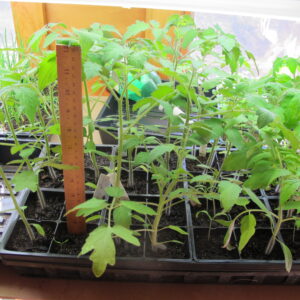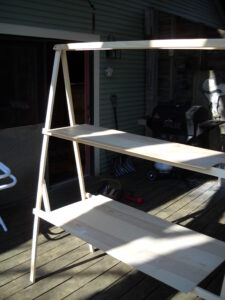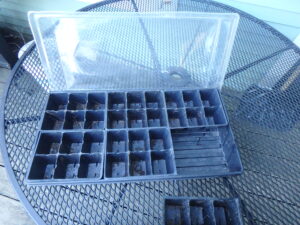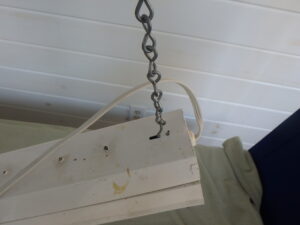I love starting seedlings indoors when it’s still cold and raw outside. It makes me dream of summer and the first red tomato. For me, it is still too early to plant most things, and I certainly don’t want to have to baby my seedlings along for 12 weeks or more. But if you haven’t ever set up grow-lights and don’t have all the equipment for indoor growing, now is the time to get everything you need before the stores sell out.

Tomato seedlings that are almost ready for the garden
First, some basics: you need lights over your seedlings in order to get good plants. Yes, I know some people grow things on a bright windowsill for a few weeks, but getting sturdy tomato plants or zesty zinnias requires supplemental lighting.
Second, you can’t use garden soil to grow your seedlings. Ordinary garden soil is too heavy and gets compacted with watering, and it may harbor fungal diseases. You need to purchase potting soil.
Last, you need a place that is at least 60 degrees, but no more than 70 degrees. Cooler temps at night are good. Electric heat mats place under your seedlings will help get quick, even germination, but are not required.
There are several types of lights for growing seedlings. For years I used fluorescent lights: 4-footers with fat T-12 tubes. These work, but now have been replaced with more energy efficient, slimmer, T-8 tubes. There are also LED grow-lights of various sorts that use even less energy, though those can be very expensive.
Sold as shop lights, T-8 2-tube fixtures should cost around $20 each, plus the fluorescent tubes which cost around $8 each. But do not, I repeat, DO NOT spend the money to buy full-spectrum tubes which cost upwards of $35 each. You are not raising plants for sale, and for the short time they will spend in your basement, regular cool white tubes are fine. Or mix cool and warm white to get a broader light spectrum.

A simple homemade plant stand
If you have a warm basement, I’d suggest that the easiest approach for a starting a few things would be to use a card table and 4-foot fluorescent fixtures hanging from the ceiling. Put plastic over the table to protect it from water spills.
You can also go to my web site,
www.Gardening-Guy.com and search for “Building a Plant Stand”. That will give step-by-step directions for building an inexpensive A-frame plant stand that will hold 6 flats, and have room below it for 4 to 6 more flats on the floor.
Your hardware store can sell you something called “jack-chain” that will allow you to adjust the height of your lights as your plants grow. Ideally, your lights will hang about 6 inches above the top of your plants. Two four-foot fixtures, each with 2 tubes, hanging a few inches apart will illuminate 4 flats (or trays) of seedlings. When you buy your flats, be sure to get those that do not have holes in the bottom, as some do.
The flimsy “six-packs” that fit into the flats come in various sizes, but I always look for the biggest, deepest cells. So, yes, you can get tiny cells that will allow you to plant 48 or even 72 plants in a flat, but there is not much room for roots.
The flimsy 6-packs tend to self-destruct easily, particularly if you try to wash them out for re-use. But there are heavy duty planting trays and cells that will last many years. Gardeners Supply sells them, along with clear domes to go over them. They cost more, but will last forever, and some have self-watering features.

A flat with 6 packs for starting seeds and a plastic cover to contain moisture
What about the soil mix for growing? Buy good quality “Seed starting mix” labeled as such. I mix it with high quality compost in a 50-50 ratio. Sometimes I make my own starting mix using peat moss, perlite, vermiculite, compost and a slow-release organic bagged fertilizer. I start about 10 flats of plants each year, so there are cost savings for making my own mix.
Seeds are very susceptible to drying out, which can be lethal. One way to keep that from happening is to check on them often. Once a day is fine. Or, if you have a busy schedule, buy clear plastic covers that fit over each flat. These, like the flats, are re-usable. They will steam up, and rain the moisture back onto your plants, just like a tropical jungle. Remove them when most cells have plants that have germinated.
How deep should you plant your seeds? About 3 times the length of the seed. Tiny seeds need just a thin sprinkling of soil mix over them. Bigger things like pumpkin seeds can be covered with half an inch of soil mix. Press down lightly with your fingers after covering the seeds so the soil mix is in good contact with the seed.

Jack chain easily allows you to adjust the height of your lights
Lastly, water them. I like a soda bottle for watering, as it can deliver a nice slow trickle. Water the soil mix before planting, because if it is too dry, it is resistant to absorbing water.
The bottom line is that starting seeds is fun. And it lets you choose plants you might not find at the garden center. So get your materials and set up your lights. I start tomatoes and other frost-sensitive plants 6 to 8 weeks before I would put them in the garden.
You may reach Henry by e-mail at
henry.homeyer@comcast.net, or by mail at PO Box 364, Cornish Flat, NH 03746. He is the author of 4 gardening books.






